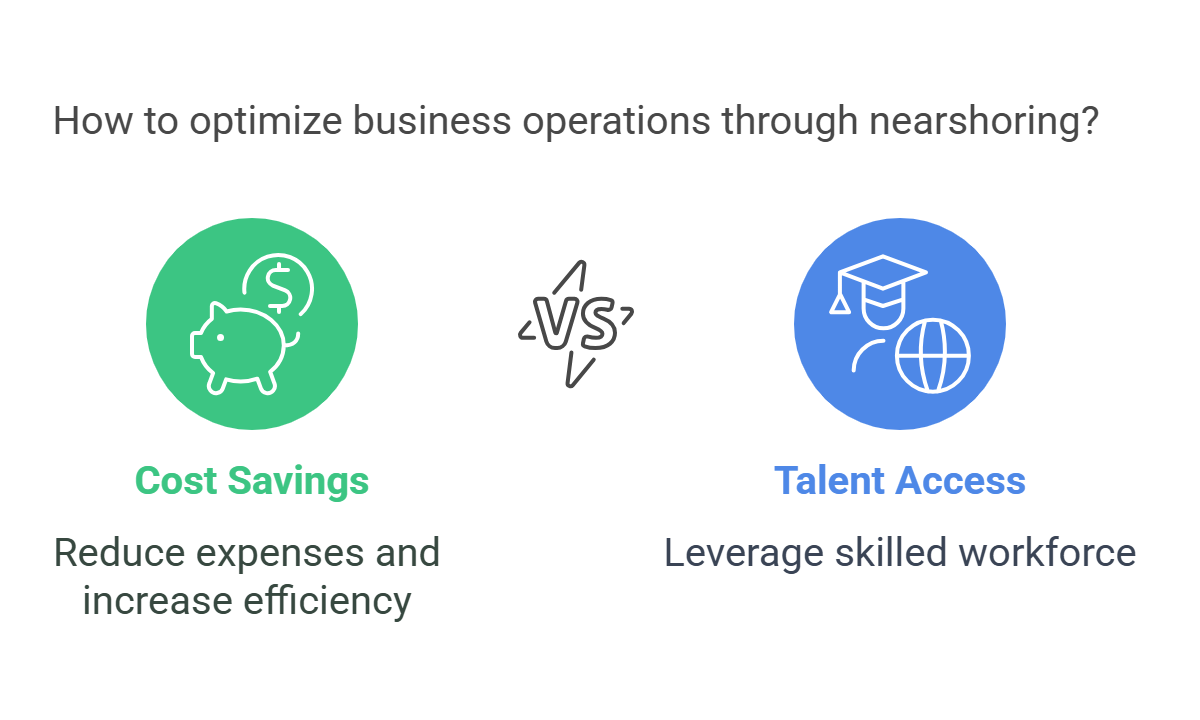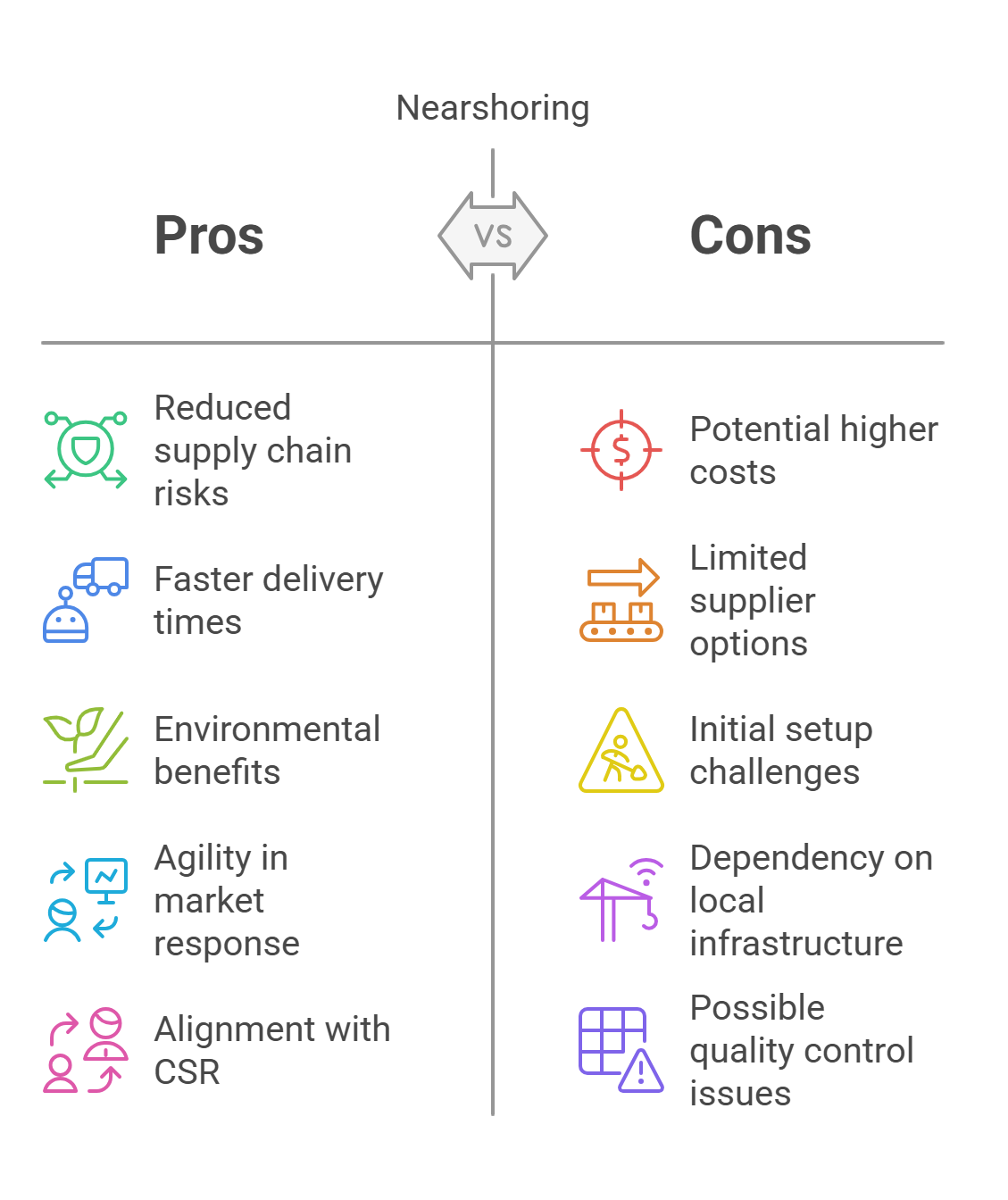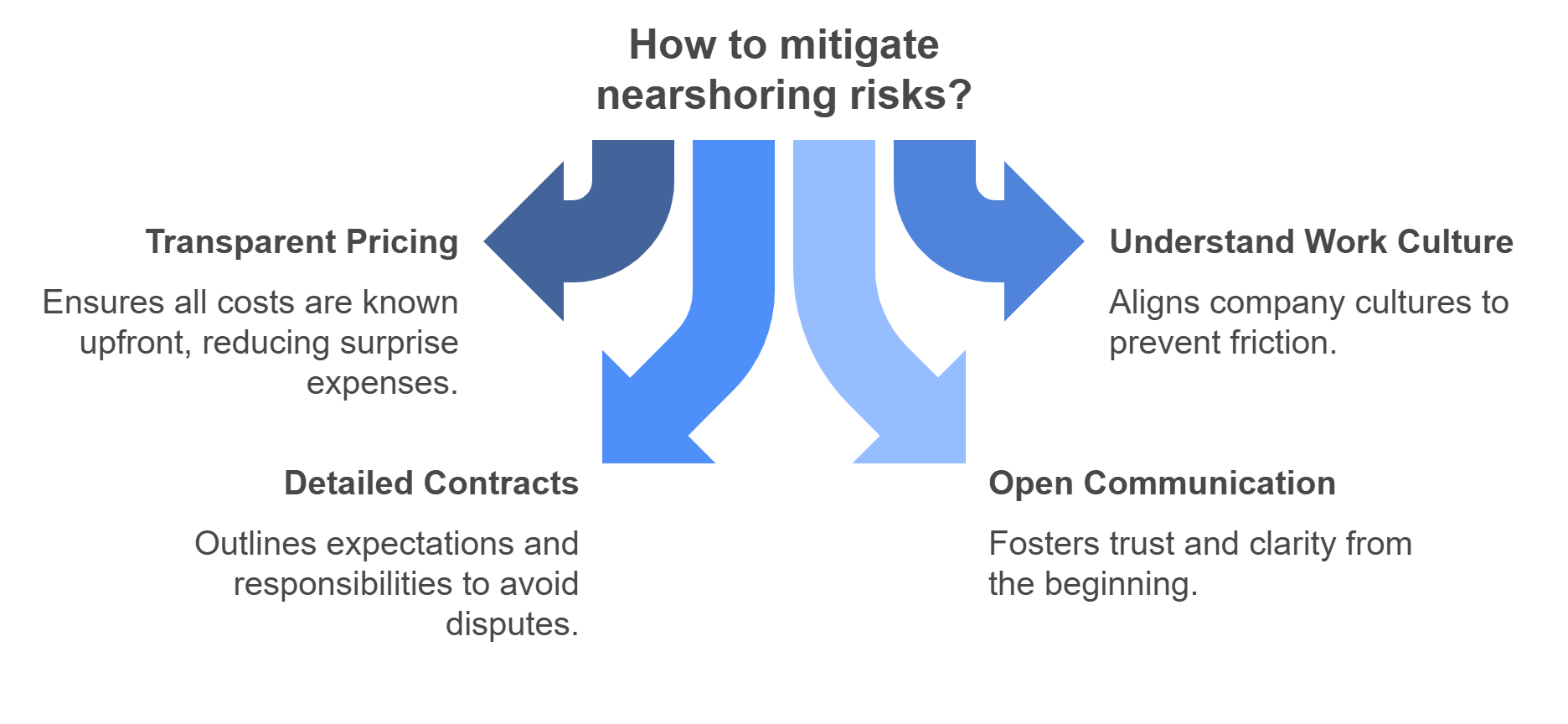Ever wondered how to streamline operations, cut costs, and keep quality high all at once? 🤔 Nearshoring might just be the answer you’ve been looking for! As the global economy gets more connected, businesses are increasingly attracted to nearshore approaches that offer closeness, cultural similarities, and great cost savings. We’ll walk through how you can pinpoint the perfect nearshoring company to hit your business targets, and we’ll highlight how Nearshorely can be your go-to guide in this journey.
After reading, you’ll know:
Nearshoring is essentially outsourcing business processes or services to companies located in nearby countries, often sharing a border or time zone. Think of it as the happy medium between sending work halfway across the globe (offshoring) and keeping it strictly within your own country (domestic outsourcing). It aims to capture the cost benefits of outsourcing while minimizing the logistical headaches and cultural gaps that can come with far-flung operations.
The big wins? Geographical proximity means easier travel for face-to-face meetings and better collaboration due to overlapping work hours. Cultural alignment often leads to smoother communication and shared work ethics. Plus, you still get significant cost effectiveness compared to keeping everything in-house or purely domestic. It’s about getting the best of both worlds, really. 😉
“Nearshoring combines the benefits of cultural and logistical advantages with cost savings you can’t find domestically.” – TTEC
One of the biggest draws is, unsurprisingly, cost savings. Setting up shop or partnering with a company in a nearby country often means lower labor costs without sacrificing the skill level you need. Beyond just wages, reduced travel expenses and shorter shipping distances also contribute to a healthier bottom line. Coupled with this are faster project turnarounds and reduced lead times – being closer just makes everything quicker!
Nearshoring isn’t just about saving money; it’s also about tapping into rich pools of skilled talent. Many nearshore locations boast highly educated workforces, particularly in tech, customer service, and manufacturing sectors. Companies can access specialized expertise that might be scarce or overly expensive in their home country, giving them a competitive edge. 💡

It’s not just small businesses hopping on the bandwagon. Big players like Apple and IBM have strategically used nearshoring (like manufacturing in Mexico or software development in Central Europe) to optimize their operations. They leverage the proximity for better supply chain management and the talent pools for innovation, proving that nearshoring can be a powerful strategy for boosting efficiency and productivity at scale.
“Nearshoring allows businesses to be more agile and responsive to market conditions, with faster project lead times and cost efficiency.” – Right People Group
First off, know thyself! Before you even start looking, get crystal clear on what you want to achieve. What specific tasks or processes are you outsourcing? What are your key performance indicators (KPIs)? Defining your objectives precisely helps you find a nearshoring company whose expertise truly lines up with your goals. Don’t just look for a vendor; look for a partner who gets your vision.
Culture matters! And so does language and time zone. Working with a team that shares similar cultural values and business ethics can make collaboration much smoother. Ensure the potential partner has strong language proficiency (usually English, but depends on your needs) to avoid misunderstandings. Time zone compatibility is crucial for real-time communication and quick problem-solving – that’s a major perk of nearshoring over offshoring.
Don’t just take their word for it – check their track record. Ask for case studies relevant to your industry and project type. Look for client testimonials or, even better, ask for references you can speak to directly. Assessing their technical skills, methodologies, and past performance gives you solid proof of their capabilities and reliability.
How do they handle communication and project management? This is make-or-break. During the selection process, pay close attention to their responsiveness, clarity, and the tools they use. Do they have established processes for reporting, feedback, and issue resolution? Effective management and open communication channels are essential for a successful partnership.
Think long-term. Is the potential partner financially stable? Can they scale their services up or down as your needs change? You want a company that will be around for the long haul and can grow with you. Checking their financial health and scalability plans helps ensure your partnership is built on a solid foundation.
“Effective communication and management ensure that your partnership with a nearshore provider aligns with your operational goals.” – ROI Call Center Solutions
Bringing production or services closer to home drastically cuts down supply chain risks. Think fewer geopolitical disruptions, reduced vulnerability to global shipping crises (like we’ve seen recently!), and quicker responses to market shifts. Shorter distances mean faster delivery times, allowing businesses to be more agile and keep customers happy with speedier fulfillment. 🚚💨
Beyond logistics, nearshoring often carries environmental advantages. Shorter transportation distances naturally mean a smaller carbon footprint compared to lengthy overseas shipping routes. For companies focused on sustainability and corporate social responsibility (CSR), this can be a significant benefit, aligning operational efficiency with green initiatives. 🌱

“Shorter transportation distances in nearshoring contribute to a lower carbon footprint, aligning with sustainability goals.” – Anvyl
When businesses look to nearshore, certain countries consistently pop up. For North American companies, Mexico is a huge favorite due to its proximity, trade agreements (USMCA), and skilled labor force, especially in manufacturing and IT. In Europe, countries like Poland, Romania, and Portugal are popular choices, offering strong technical talent, competitive costs, and cultural affinity within the EU context. Costa Rica is another standout in Latin America, known for its political stability, educated workforce, and growing tech scene.
Different regions often specialize. Central and Eastern Europe, for instance, have become major hubs for software development and IT services, boasting excellent technical universities and a deep pool of engineers. Latin America excels not only in IT but also in customer support and BPO (Business Process Outsourcing), often with strong English language skills. Mexico remains a powerhouse for manufacturing and assembly operations.
Success stories abound. Many US tech firms have established thriving development centers in Guadalajara, Mexico (often dubbed the “Silicon Valley of Mexico”). European automotive companies frequently leverage manufacturing capabilities in countries like Poland or the Czech Republic. These real-world examples show how companies effectively use regional strengths through nearshoring to gain a competitive advantage.
“In Latin America, countries like Argentina and Costa Rica rank among the top 50 for English proficiency, making them ideal for seamless collaboration.” – Hire With Near
While nearshoring offers many advantages, it’s not without potential bumps in the road. Sometimes “hidden costs” can pop up, like unexpected travel needs, legal fees for cross-border contracts, or infrastructure setup costs that weren’t initially accounted for. Misalignment in company culture or work pace can also create friction, even with geographical closeness. It’s important to anticipate these possibilities.
Mitigating these risks comes down to diligence and clear agreements. Insist on transparent pricing models and discuss potential extra costs upfront. Invest time in understanding the partner’s work culture and ensure alignment. Most importantly, create detailed contracts (Service Level Agreements or SLAs) that clearly outline expectations, responsibilities, performance metrics, and protocols for handling disagreements or issues. Open, honest communication from day one is key.

Feeling overwhelmed by the options? That’s where Nearshorely steps in! We specialize in connecting businesses like yours with rigorously vetted, high-quality nearshoring partners across various industries and regions. We take the guesswork out of the equation, matching your specific needs with companies that have the right skills, experience, and cultural fit. Think of us as your expert matchmaker for nearshoring success. 🤝
For instance, we recently helped a mid-sized software company find the perfect development team in Costa Rica through our network. They were struggling with high domestic costs and needed specialized skills they couldn’t find locally. Nearshorely identified a partner with proven expertise in their required tech stack and a compatible company culture. The result? A seamless integration, faster development cycles, and significant cost savings, allowing them to accelerate their product roadmap. Let us help you write your own success story!
Great partnerships thrive on great communication. Establish clear channels (like regular video calls, shared project management tools, and designated points of contact) right from the start. Be explicit about your expectations regarding deliverables, timelines, reporting, and quality standards. Documenting everything in an SLA helps, but ongoing, open dialogue prevents small misunderstandings from becoming big problems.
Don’t just “set it and forget it.” Schedule regular performance reviews to discuss what’s working well and what needs improvement. Provide constructive feedback and be open to receiving it too! Celebrating wins together and addressing challenges collaboratively builds trust and strengthens the relationship over time, turning a simple vendor agreement into a true strategic partnership.
What industries benefit most from nearshoring?
Many industries benefit! IT and software development, customer support centers, manufacturing, finance and accounting services, and creative services (like design and marketing) are particularly common areas where nearshoring provides great value due to talent availability and cost structures.
How does nearshoring compare to offshoring?
Nearshoring involves outsourcing to nearby countries (e.g., US to Mexico, Germany to Poland), offering benefits like similar time zones, cultural affinity, and easier travel. Offshoring means outsourcing to distant countries (e.g., US to India or the Philippines), often providing greater cost savings but potentially facing challenges with time differences, cultural gaps, and travel logistics.
What should I look for in a nearshoring contract?
A solid contract should clearly define the scope of work, service levels (SLAs), pricing and payment terms, intellectual property rights, data security measures, confidentiality clauses, termination conditions, and dispute resolution processes. Clarity here protects both parties.
Are there upfront costs associated with nearshoring?
Yes, there can be. Depending on the model, you might encounter setup fees, costs for initial travel and training, technology integration expenses, or legal fees for contract review. Discuss these potential costs openly with potential partners to get a full picture of the investment needed.
How do I ensure data security with a nearshoring company?
Verify the company’s security certifications (like ISO 27001 or SOC 2), review their data protection policies, understand their physical and network security measures, and ensure your contract includes strong data security and confidentiality clauses. Regular audits and clear protocols are essential.
Finding the right nearshoring company is a strategic move that can genuinely reshape your business operations, boosting efficiency while keeping costs in check. By carefully assessing key factors like skills, culture, communication, and stability, and by working with trusted connectors like Nearshorely, businesses can confidently harness the power of nearshoring to achieve their objectives more effectively.
Key Takeaways:
Ready to explore how nearshoring can boost your business? Contact Nearshorely today and let us connect you with a partner perfectly suited to your unique business needs! ✨